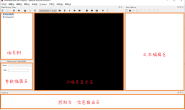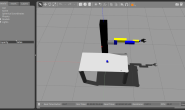TF坐标变换基础
机器人建模和控制必须掌握坐标系和坐标变换等基础知识。机器人在空间中运动主要有两种形式:
- 平移和旋转
也就是线速度和角速度。  坐标关系不仅包括机器人和外部环境,也包括机器人自身各部件,如本体,传感器(摄像头),控制器,执行器(电机)等。
坐标关系不仅包括机器人和外部环境,也包括机器人自身各部件,如本体,传感器(摄像头),控制器,执行器(电机)等。  TF概念如下图所示:
TF概念如下图所示:  在日常生活中,如果将现实环境建立数学或物理模型必然也离不开坐标系,如下图:
在日常生活中,如果将现实环境建立数学或物理模型必然也离不开坐标系,如下图:  常见的如GPS全局坐标,室内定位局部坐标等,在机器人领域示例如下:
常见的如GPS全局坐标,室内定位局部坐标等,在机器人领域示例如下:  教程不仅有理论介绍,还有云平台实践环境:
教程不仅有理论介绍,还有云平台实践环境: 
 分别展示了两款机器人模型中的TF。 下面我们先把坐标系基本概念过一遍:
分别展示了两款机器人模型中的TF。 下面我们先把坐标系基本概念过一遍: 








 示例演示:
示例演示: 
roslaunch turtle_tf2 turtle_tf2_demo_cpp.launch
使用键盘控制控制第一个turtle,第二个跟随,如下图所示: 

<launch>
<!-- Turtlesim Node-->
<node pkg="turtlesim" type="turtlesim_node" name="sim"/>
<node pkg="turtlesim" type="turtle_teleop_key" name="teleop" output="screen"/>
<!-- Axes -->
<param name="scale_linear" value="2" type="double"/>
<param name="scale_angular" value="2" type="double"/>
<node name="turtle1_tf2_broadcaster" pkg="turtle_tf2" type="turtle_tf2_broadcaster" respawn="false" output="screen" >
<param name="turtle" type="string" value="turtle1" />
</node>
<node name="turtle2_tf2_broadcaster" pkg="turtle_tf2" type="turtle_tf2_broadcaster" respawn="false" output="screen" >
<param name="turtle" type="string" value="turtle2" />
</node>
<node name="turtle_pointer" pkg="turtle_tf2" type="turtle_tf2_listener" respawn="false" output="screen" >
</node>
</launch>
注意:由于noetic版本仅支持python3。 为了更方便的调试和查看坐标,ROS-TF2提供了大量的工具: 
import rospy
import tf2_py as tf2
import yaml
import subprocess
from tf2_msgs.srv import FrameGraph
import tf2_ros
def main():
rospy.init_node('view_frames')
# listen to tf for 5 seconds
rospy.loginfo('Listening to tf data during 5 seconds...')
rospy.sleep(0.00001)
buffer = tf2_ros.Buffer()
listener = tf2_ros.TransformListener(buffer)
rospy.sleep(5.0)
rospy.loginfo('Generating graph in frames.pdf file...')
rospy.wait_for_service('~tf2_frames')
srv = rospy.ServiceProxy('~tf2_frames', FrameGraph)
data = yaml.safe_load(srv().frame_yaml)
with open('frames.gv', 'w') as f:
f.write(generate_dot(data))
subprocess.Popen('dot -Tpdf frames.gv -o frames.pdf'.split(' ')).communicate()
def generate_dot(data):
if len(data) == 0:
return 'digraph G { "No tf data received" }'
dot = 'digraph G {\n'
for el in data:
map = data[el]
dot += '"'+map['parent']+'" -> "'+str(el)+'"'
dot += '[label=" '
dot += 'Broadcaster: '+map['broadcaster']+'\\n'
dot += 'Average rate: '+str(map['rate'])+'\\n'
dot += 'Buffer length: '+str(map['buffer_length'])+'\\n'
dot += 'Most recent transform: '+str(map['most_recent_transform'])+'\\n'
dot += 'Oldest transform: '+str(map['oldest_transform'])+'\\n'
dot += '"];\n'
if not map['parent'] in data:
root = map['parent']
dot += 'edge [style=invis];\n'
dot += ' subgraph cluster_legend { style=bold; color=black; label ="view_frames Result";\n'
dot += '"Recorded at time: '+str(rospy.Time.now().to_sec())+'"[ shape=plaintext ] ;\n'
dot += '}->"'+root+'";\n}'
return dot
if __name__ == '__main__':
main()






 坐标为静态关系:
坐标为静态关系: 
 坐标为动态关系:
坐标为动态关系:  坐标与时间关系:
坐标与时间关系: 
 坐标与机器人关系:
坐标与机器人关系: 




 这个坐标变换TF2工具的意义如上所示,但是可能会觉得不是很清楚,下面举个例子:
这个坐标变换TF2工具的意义如上所示,但是可能会觉得不是很清楚,下面举个例子:  观察上图绿点的位置,通常我们需要机器人本体坐标,但是传感器并非安装在本体中心,而传感器获取的各类信息都是相对传感器的数据,而非机器人本体,TF2工具可以直接维护这些位置姿态坐标关系,将其转换为机器人本体坐标。
观察上图绿点的位置,通常我们需要机器人本体坐标,但是传感器并非安装在本体中心,而传感器获取的各类信息都是相对传感器的数据,而非机器人本体,TF2工具可以直接维护这些位置姿态坐标关系,将其转换为机器人本体坐标。  tf2常用功能包: examples-tf2-py: 使用tf2库的Python API示例。 geometry2: 用于在ros,tf2中引入默认软件包第二代坐标变换库的元软件包。 robot-state-publisher: 状态发布后,对于使用tf2的系统中的所有组件都可用。 该包使用机器人的运动学树模型将机器人的关节角度作为输入,并发布机器人链接的3D姿势。 ros-base: 一个扩展“ ros_core”并包含其他基本功能(如tf2和urdf)的软件包。 tf2: tf2保持时间缓冲的树结构中的坐标系之间的关系,并允许用户在任意所需的时间点在任意两个坐标系之间转换点,向量等。 tf2-ros: 该软件包包含适用于Python和C ++的tf2库的ROS绑定。 其他库:tf2-bullet, tf2-eigen, tf2-geometry-msgs, tf2-kdl, tf2-msgs, tf2-py, tf2-sensor-msgs, tf2-tools。
tf2常用功能包: examples-tf2-py: 使用tf2库的Python API示例。 geometry2: 用于在ros,tf2中引入默认软件包第二代坐标变换库的元软件包。 robot-state-publisher: 状态发布后,对于使用tf2的系统中的所有组件都可用。 该包使用机器人的运动学树模型将机器人的关节角度作为输入,并发布机器人链接的3D姿势。 ros-base: 一个扩展“ ros_core”并包含其他基本功能(如tf2和urdf)的软件包。 tf2: tf2保持时间缓冲的树结构中的坐标系之间的关系,并允许用户在任意所需的时间点在任意两个坐标系之间转换点,向量等。 tf2-ros: 该软件包包含适用于Python和C ++的tf2库的ROS绑定。 其他库:tf2-bullet, tf2-eigen, tf2-geometry-msgs, tf2-kdl, tf2-msgs, tf2-py, tf2-sensor-msgs, tf2-tools。
机器人模型与TF2工具应用案例:
ROS1(noetic,melodic,kinetic,indigo):  注意:xacro,sdf等格式适合Gazebo,urdf格式适合rviz。
注意:xacro,sdf等格式适合Gazebo,urdf格式适合rviz。
rosrun xacro xacro -o model_out.urdf model_in.urdf.xacro
使用如下命令打开一个机器人模型(此处不要求掌握,后续详细介绍):
roslaunch robot1_description display.launch model:=robot1_base1.urdf
rosrun tf2_tools echo.py base_link wheel_1
rosrun tf2_tools view_frames.py

 ROS2(foxy,dashing): 机器人urdf模型通用!!!
ROS2(foxy,dashing): 机器人urdf模型通用!!!
ros2 launch urdf_tutorial display.launch.py model:=src/urdf/robot1_base1.urdf
ros2 run tf2_tools view_frames.py


 ROS1和ROS2几乎一致! 下一节,将通过URDF构建机器人模型,以ROS2(foxy)讲解为主!主要是ROS1相关URDF功能如何顺利移植到ROS2中!
ROS1和ROS2几乎一致! 下一节,将通过URDF构建机器人模型,以ROS2(foxy)讲解为主!主要是ROS1相关URDF功能如何顺利移植到ROS2中!
附录(ros2 foxy):
display.launch.py
import launch
from launch.substitutions import Command, LaunchConfiguration
import launch_ros
import os
def generate_launch_description():
pkg_share = launch_ros.substitutions.FindPackageShare(package='urdf_tutorial').find('urdf_tutorial')
default_model_path = os.path.join(pkg_share, 'urdf/01-myfirst.urdf')
default_rviz_config_path = os.path.join(pkg_share, 'rviz/urdf.rviz')
robot_state_publisher_node = launch_ros.actions.Node(
package='robot_state_publisher',
executable='robot_state_publisher',
parameters=[{'robot_description': Command(['xacro ', LaunchConfiguration('model')])}]
)
joint_state_publisher_node = launch_ros.actions.Node(
package='joint_state_publisher',
executable='joint_state_publisher',
name='joint_state_publisher',
condition=launch.conditions.UnlessCondition(LaunchConfiguration('gui'))
)
joint_state_publisher_gui_node = launch_ros.actions.Node(
package='joint_state_publisher_gui',
executable='joint_state_publisher_gui',
name='joint_state_publisher_gui',
condition=launch.conditions.IfCondition(LaunchConfiguration('gui'))
)
rviz_node = launch_ros.actions.Node(
package='rviz2',
executable='rviz2',
name='rviz2',
output='screen',
arguments=['-d', LaunchConfiguration('rvizconfig')],
)
return launch.LaunchDescription([
launch.actions.DeclareLaunchArgument(name='gui', default_value='True',
description='Flag to enable joint_state_publisher_gui'),
launch.actions.DeclareLaunchArgument(name='model', default_value=default_model_path,
description='Absolute path to robot urdf file'),
launch.actions.DeclareLaunchArgument(name='rvizconfig', default_value=default_rviz_config_path,
description='Absolute path to rviz config file'),
joint_state_publisher_node,
joint_state_publisher_gui_node,
robot_state_publisher_node,
rviz_node
])
robot1_base1.urdf
<?xml version="1.0" ?>
<robot name="robot1_xacro" xmlns:controller="http://playerstage.sourceforge.net/gazebo/xmlschema/#controller" xmlns:interface="http://playerstage.sourceforge.net/gazebo/xmlschema/#interface" xmlns:sensor="http://playerstage.sourceforge.net/gazebo/xmlschema/#sensor">
<link name="base_footprint">
<visual>
<geometry>
<box size="0.001 0.001 0.001"/>
</geometry>
<origin rpy="0 0 0" xyz="0 0 0"/>
</visual>
<inertial>
<mass value="0.0001"/>
<inertia ixx="1.0" ixy="0.0" ixz="0.0" iyy="1.0" iyz="0.0" izz="1.0"/>
</inertial>
</link>
<gazebo reference="base_footprint">
<material>Gazebo/Green</material>
<turnGravityOff>false</turnGravityOff>
</gazebo>
<joint name="base_footprint_joint" type="fixed">
<origin xyz="0 0 0"/>
<parent link="base_footprint"/>
<child link="base_link"/>
</joint>
<link name="base_link">
<visual>
<geometry>
<box size="0.2 .3 .1"/>
</geometry>
<origin rpy="0 0 1.54" xyz="0 0 0.05"/>
<material name="white">
<color rgba="1 1 1 1"/>
</material>
</visual>
<collision>
<geometry>
<box size="0.2 .3 0.1"/>
</geometry>
</collision>
<inertial>
<mass value="10"/>
<inertia ixx="1.0" ixy="0.0" ixz="0.0" iyy="1.0" iyz="0.0" izz="1.0"/>
</inertial>
</link>
<link name="wheel_1">
<visual>
<geometry>
<cylinder length="0.05" radius="0.05"/>
</geometry>
<origin rpy="0 0 0" xyz="0 0 0"/>
<material name="black">
<color rgba="0 0 0 1"/>
</material>
</visual>
<collision>
<geometry>
<cylinder length="0.05" radius="0.05"/>
</geometry>
</collision>
<inertial>
<mass value="1"/>
<inertia ixx="1.0" ixy="0.0" ixz="0.0" iyy="1.0" iyz="0.0" izz="1.0"/>
</inertial>
</link>
<link name="wheel_2">
<visual>
<geometry>
<cylinder length="0.05" radius="0.05"/>
</geometry>
<origin rpy="0 0 0" xyz="0 0 0"/>
<material name="black"/>
</visual>
<collision>
<geometry>
<cylinder length="0.05" radius="0.05"/>
</geometry>
</collision>
<inertial>
<mass value="1"/>
<inertia ixx="1.0" ixy="0.0" ixz="0.0" iyy="1.0" iyz="0.0" izz="1.0"/>
</inertial>
</link>
<link name="wheel_3">
<visual>
<geometry>
<cylinder length="0.05" radius="0.05"/>
</geometry>
<origin rpy="0 0 0" xyz="0 0 0"/>
<material name="black"/>
</visual>
<collision>
<geometry>
<cylinder length="0.05" radius="0.05"/>
</geometry>
</collision>
<inertial>
<mass value="1"/>
<inertia ixx="1.0" ixy="0.0" ixz="0.0" iyy="1.0" iyz="0.0" izz="1.0"/>
</inertial>
</link>
<link name="wheel_4">
<visual>
<geometry>
<cylinder length="0.05" radius="0.05"/>
</geometry>
<origin rpy="0 0 0" xyz="0 0 0"/>
<material name="black"/>
</visual>
<collision>
<geometry>
<cylinder length="0.05" radius="0.05"/>
</geometry>
</collision>
<inertial>
<mass value="1"/>
<inertia ixx="1.0" ixy="0.0" ixz="0.0" iyy="1.0" iyz="0.0" izz="1.0"/>
</inertial>
</link>
<joint name="base_to_wheel1" type="continuous">
<parent link="base_link"/>
<child link="wheel_1"/>
<origin rpy="1.5707 0 0" xyz="0.1 0.15 0"/>
<axis xyz="0 0 1"/>
</joint>
<joint name="base_to_wheel2" type="continuous">
<axis xyz="0 0 1"/>
<anchor xyz="0 0 0"/>
<limit effort="100" velocity="100"/>
<parent link="base_link"/>
<child link="wheel_2"/>
<origin rpy="1.5707 0 0" xyz="-0.1 0.15 0"/>
</joint>
<joint name="base_to_wheel3" type="continuous">
<parent link="base_link"/>
<axis xyz="0 0 1"/>
<child link="wheel_3"/>
<origin rpy="1.5707 0 0" xyz="0.1 -0.15 0"/>
</joint>
<joint name="base_to_wheel4" type="continuous">
<parent link="base_link"/>
<axis xyz="0 0 1"/>
<child link="wheel_4"/>
<origin rpy="1.5707 0 0" xyz="-0.1 -0.15 0"/>
</joint>
</robot>
~Fin~









